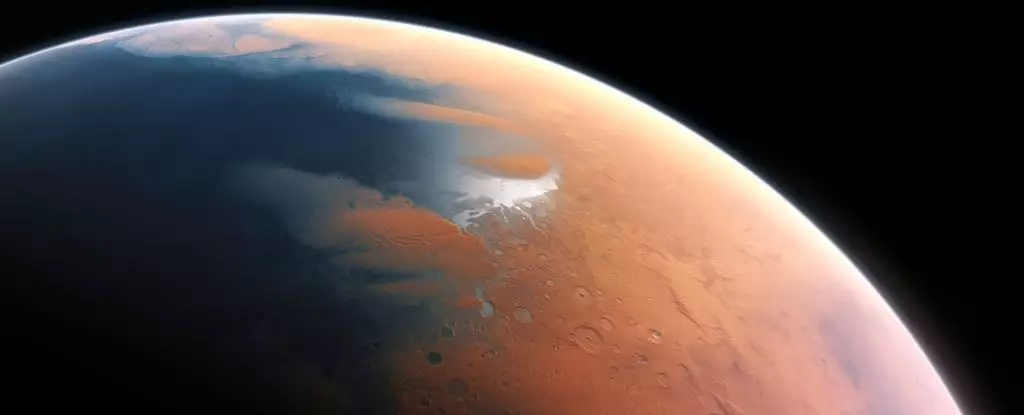Beneath the arid, dusty expanses of Mars lies a mystery that could transform our understanding of the Red Planet: the presence of substantial reservoirs of liquid water trapped deep within its crust. For decades, scientists have been fascinated by the remnants of ancient lakes and rivers scattered on the Martian surface, yet the question remains—where did all the water go? Recent findings suggest that a significant portion of this water resides underground, possibly waiting to be discovered and studied.
The evidence emerging from NASA’s InSight mission is particularly compelling. Utilizing seismic data collected from this lander’s super-sensitive instruments, researchers have detected signs of a low-velocity layer located approximately 5.4 to 8 kilometers below Mars’ surface. This anomaly indicates that the seismic waves produced by quakes slow down as they pass through this layer, leading scientists to hypothesize that it could be filled with liquid water—a crucial piece of the puzzle in Mars’ hydrological history.
Understanding Mars’ Hydrological Evolution
Historically, Mars was not the desolate desert we know today. During the Noachian and Hesperian epochs, roughly 4.1 to 3 billion years ago, the planet was characterized by flowing rivers and shimmering lakes. Over time, however, as Mars’ magnetic field weakened and its atmosphere thinned, much of this water disappeared. The processes of evaporation, freezing, and absorption into minerals cannot fully explain the vast quantity of “missing” water that scientists estimate could be enough to form an ocean over 700 meters deep.
The prevailing theory is that much of Mars’ lost water has seeped into the planet’s crust. The intense meteorite bombardment that occurred during the Noachian period likely created fractures in the surface, providing potential channels for water to migrate underground. In a warmer, deeper environment, this water could remain in liquid form, creating an underground reservoir of significant size.
A Groundbreaking Discovery through Seismic Waves
NASA’s InSight mission, which landed on Mars in 2018, has been pivotal in probing the planet’s internal structure using advanced seismological tools. Seismic waves, particularly shear waves, revealed a striking underground anomaly that may point to an extensive aquifer layer, akin to Earth’s aquifers. What’s remarkable is the computed volume of water in this aquifer may far exceed even the water stored in Antarctica’s ice sheet. Estimates suggest it could hold enough water to form an ocean that would blanket the planet to a depth of 520 to 780 meters.
The key to this discovery was the seismic data collected from impactful events on the Martian surface, such as quakes and meteorite strikes. These phenomena sent ripples through the crust comparable to a pebble dropped in water, much like how seismic vibrations allow researchers to map subsurface geology. By analyzing these vibrations, scientists could identify the layers of rock and discern their unique signatures, eventually revealing the presence of this water-rich zone.
The Implications for Life and Future Exploration
The existence of liquid water beneath Mars’ surface carries profound implications, particularly regarding the possibility of life. On Earth, deep subterranean environments house microbial life that thrives in such conditions. This raises the tantalizing question: Could Martian life, perhaps remnants of ancient ecosystems, exist in these hidden aquifers? If so, the implications could reshape our understanding of life’s adaptability in extreme environments.
Moreover, these aquifers present a potential resource for future human explorers on Mars. Water not only supports life but can also be transformed into oxygen or used as rocket fuel for return trips to Earth. However, accessing these resources on another planet is fraught with challenges, particularly the need for careful drilling techniques. There’s a growing awareness of the risk of contaminating these pristine Martian reservoirs with Earthly microbes, underscoring the need for stringent planetary protection measures.
Looking to the Future: Mapping Mars’ Water Layers
The seismic data collected thus far has only scratched the surface of Mars’ potential water layers. Future missions equipped with seismic monitoring technology are essential to create a comprehensive map of where these water reservoirs may exist across the planet. Areas like the icy mud reservoir of Utopia Planitia might reveal additional accessible water sources, further enriching our understanding of Mars.
The revelation of substantial aquifers beneath Mars’ surface opens up new avenues for research and exploration. As we continue to decode the seismic signals of the Red Planet, we may find that Mars has more in common with Earth than we ever imagined. The promise of liquid water beckons us forward, highlighting both the challenges and the extraordinary possibilities of Martian exploration.


Leave a Reply